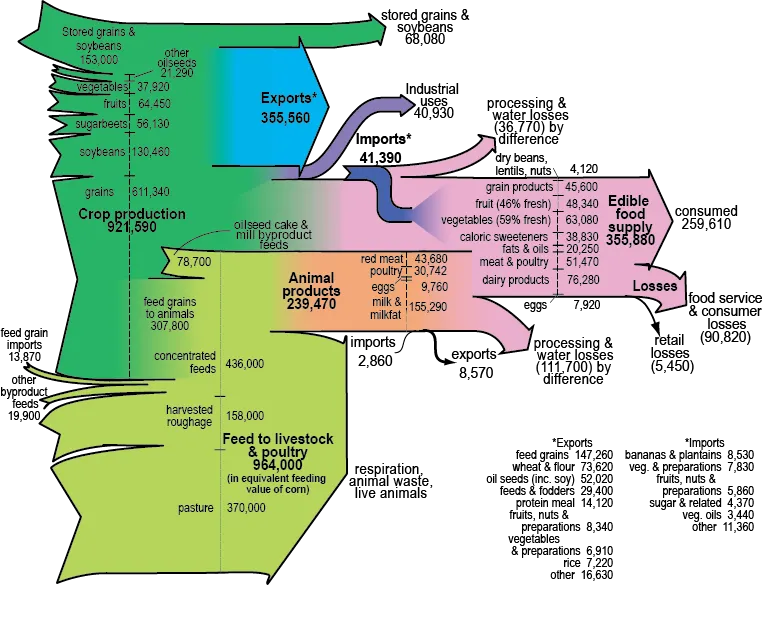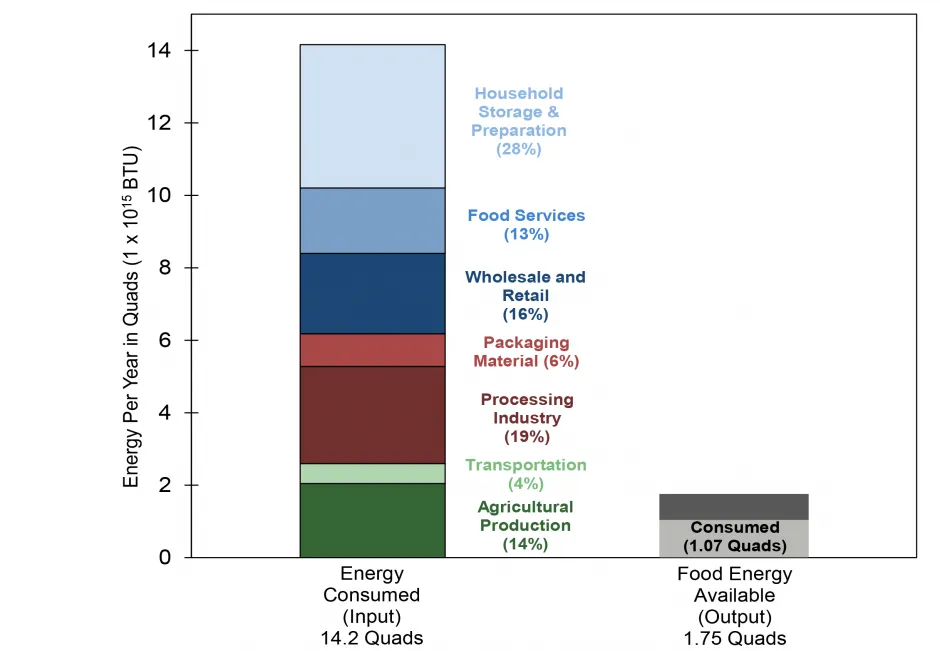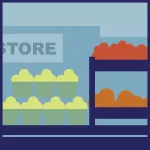U.S. Food System Factsheet
Americans enjoy a diverse abundance of low-cost food, spending a mere 11.3% of disposable income on food.1 However, store prices do not reflect the external costs—economic, social, and environmental—that impact the sustainability of the food system. Considering the full life cycle of the U.S. food system illuminates the connection between consumption behaviors and production practices.
The Food System Life Cycle

Patterns of Use
Agricultural Production
- Farmers account for 1% of the population. Over 60% of these farmers are above the age of 55.2,3
- Large-scale family farms and industrial nonfamily farms account for only 5% of farms, but 63.8% of production (in $). Small-scale family farms represent 89% of U.S. farms, but only 17.8% of production.4
- Just 14.5¢ of every dollar spent on food in 2021 went back to the farm; in 1975, it was 40¢.5,6
- In 2018-2020, 41% of the hired agricultural labor force lacked authorization to work in the United States.7
- From 1992 to 2012, total cropland decreased from 460 million acres to 392 million acres.8
- Many parts of the U.S., including agricultural regions, are experiencing increasing groundwater depletion (withdrawal exceeds recharge rate).9 In 2015, 118,000 million gallons per day of water were used for irrigation - 52% of this water came from surface-water sources.10
- In 2017, the amount of irrigated farmland in the U.S. was over 58 million acres, 2 million more acres than in 2012.2
- Nutrient runoff from the upper agricultural regions of the Mississippi River watershed creates a hypoxic “dead zone” in the Gulf of Mexico. The 2017 hypoxic dead zone was the largest measured since 1985, at 8,776 sq mi.11
- From 2007 to 2012, pesticide use increased by 10% while herbicide use increased by 20% from 2010 to 2014. In 2012, the U.S. agriculture sector used 899 million pounds of pesticides.12
- In 2000, 25% of corn, 61% of cotton, and 54% of soybeans planted were genetically engineered; by 2022, these percentages increased to 93%, 95%, and 95%, respectively.13
- The UN’s Food and Agriculture Organization estimates 75 billion metric tons (Gt) of soil are lost annually to erosion from fertile lands.14
- Agriculture was responsible for 10% of total U.S. greenhouse gas (GHGs) emissions in 2021. Methane (CH4), nitrous oxide (N2O), and carbon dioxide (CO2) are the main GHGs emitted by agricultural activities. Livestock and soil management are major contributors.15
Consumption Patterns
- In 2010, the U.S. food supply provided 4,000 calories per person per day.17 Accounting for waste, the average American consumed 2,501 calories per day in 2010, an increase of 22% from 1970.18
- In 2021, 185 lbs of meat per person were available for consumption, up 11.6 lbs from 1969. Although red meat consumption declined 24% since the 1970s, chicken consumption has increased.19
- 34% of grains grown are used to feed animals.20
- 22.2 teaspoons of sweeteners are available per capita in the U.S. daily; the American Heart Association recommends limiting added sugars to 6 and 9 teaspoons daily for average females and males, respectively.21,22
- Approximately 41% of U.S. adults and over 20% of 12-19 year olds are obese (BMI > 30).23
- Diet plays a significant role in health. Diets lacking fruits and vegetables can increase risk of heart disease, certain cancers, and stroke—leading causes of U.S. deaths.23,24
- The EPA estimates that 30%-40% of the current food supply was lost as waste, 50% more than in 1970.25,26 More food waste reaches landfills than any other material. This waste accounted for roughly 22% of the municipal solid waste stream in 2018 and represents a loss of $450 and around 350 pounds of food waste per person each year.25,26,27
- One estimate suggests that 2% of total annual energy use in the U.S. is used to produce food that is later wasted.28
Material Flow in the U.S. Food System16 (1995, flows in million pounds)

Life Cycle Impacts
The energy used by a system is often a useful indicator of its sustainability. Food-related energy use accounts for over 12% of the national energy budget.31 Agriculture and the food system as a whole have developed a dependence on fossil energy; 13 units of (primarily) fossil energy are used for every unit of food energy produced.18,29
- Food production of U.S. self-selected diets results in 4.7 kg CO₂e and 25.2 MJ fossil fuel energy demand per capita per day.32
- Reliance on fossil fuel inputs makes the food system vulnerable to oil price fluctuations.16
- Consolidation of farms, food processing operations, and distribution warehouses often increases distance between food sources and consumers.16
- Consolidation in the food system is also concentrating management decisions into fewer hands. For example:
- Four firms control 85% of the beef packing market; 82% of soybean processing is controlled by four firms.33
- The top four food retailers sold almost 35% of America’s food in 2019, compared to only 15% in 1990.34
Energy Flow in the U.S. Food System16,17,18,29,30

Solutions and Sustainable Alternatives
Eat Less Meat
Meat-based diets use more energy to produce than vegetarian diets, one study suggests twice as much.16 One serving of beef has more associated GHG emissions than 20 servings of vegetables.35 Current meat production also has significant environmental impacts on land use, water use, and water pollution.36 In an average diet, meat consumption accounts for 31% of the water scarcity footprint— the water use that accounts for regional scarcity.37 20% of Americans cause half of the food-related GHG emissions; a diet shift away from meat could reduce this up to 73%.32,38
Reduce Waste
Much of household food waste is due to spoilage. Prevent this by buying smaller amounts; planning meals and sticking to shopping lists; and freezing, canning, or preserving extra produce.39 Direct-to-consumer meals streamline the supply chain, reduce food waste and last-mile transportation, and have 25% lower GHG emissions than a store bought meal.40 Many safe foods are thrown out due to confusion about “sell-by” and “use-by” dates; for guidance, see the USDA.41 Whether washing dishes manually or in a dishwasher, save water and energy by practices such as not letting water run constantly, rinsing in cold water, only running dishwashers with full loads, and avoiding pre-rinsing dishes.42
Use Less Refrigeration
Home refrigeration accounts for 13% of all energy consumed by our food system.16 Refrigerator efficiency more than doubled from 1972 to 1990, when the first set of efficiency standards took effect. Yet increases in size have largely offset this improvement.16,43 Today’s convenience foods rely heavily on refrigeration for preservation. Switching out old refrigerators with more efficient models (e.g., ENERGY STAR) can save energy and money. Also consider buying smaller quantities of fresh produce more frequently.16,44
Eat organic
Organic farms do not use chemicals that require large amounts of energy to produce, pollute soil and water, and cause human health impacts. U.S. sales of organic food in 2022 were $61.7 billion, 19.6% higher than in 2019; organic food now accounts for approximately 6% of all food sold in the U.S.45
Eat local
Transportation accounts for approximately 14% of the total energy used in the U.S. food system.46 There is significant room for improvement in how people acquire their food. Community Supported Agriculture and Farmers Markets are great ways to support your local food system.
Center for Sustainable Systems, University of Michigan. 2023. "U.S. Food System Factsheet." Pub. No. CSS01-06.
References
- U.S. Department of Agriculture (USDA), Economic Research Service (ERS) (2023) Food Expenditure Series: Normalized food expenditures by all purchasers and household final users.
- USDA, ERS (2019) 2017 Census of Agriculture.
- U.S. Census Bureau (2019) “Monthly Population Estimates for the U.S.”
- USDA (2022) America’s Diverse Family Farms.
- USDA, ERS (2023) Food Dollar Series.
- Elitzak, H. (1999) Food Cost Review, 1950-97. USDA, Agricultural Economic Report 780.
- USDA, ERS (2023) Farm Labor.
- USDA, ERS (2017) “Cropland, 1945-2012, by State.”
- Konikow, L. (2013) Groundwater depletion in the United States (1900-2008). U.S. Geological Survey (USGS) Scientific Investigations Report.
- USGS (2019) “Irrigation Water Use.”
- National Oceanic and Atmospheric Administration (NOAA) (2017) “Gulf of Mexico ‘Dead Zone’ is the Largest ever Measured.”
- USDA, ERS (2019) Agricultural Resources and Environmental Indicators, 2019.
- USDA, ERS (2022) “Adoption of Genetically Engineered Crops in the U.S.”
- Borrelli, P., et al. (2017) “An assessment of the global impact of 21st century land use change on soil erosion.” Nature Communications, 8(1).
- U.S. Environmental Protection Agency (EPA) (2023) Inventory of U.S. Greenhouse Gas Emissions and Sinks 1990 - 2021.
- Heller, M. and G. Keoleian (2000) Life Cycle-Based Sustainability Indicators for Assessment of the U.S. Food System, The University of Michigan Center for Sustainable Systems, CSS00-04.
- USDA, ERS (2015) “Archived Tables - Nutrient Availability.”
- USDA, ERS (2019) “Loss-Adjusted Food Availability - Calories.”
- USDA, ERS (2022) “Food Availability.”
- USDA, ERS (2023) Feed Grains Yearbook Tables.
- USDA, ERS (2022) “Loss-Adjusted Food Availability - Sugar and sweeteners (added).”
- American Heart Association (2019) Added Sugar Is Not So Sweet - Infographic.
- U.S. Department of Health and Human Services (2021) “Health, United States, 2019.”
- Harvard T.H. Chan, School of Public Health (2016) “What Should I Eat: Vegetables and Fruits.”
- U.S. EPA (2023) “U.S. 2030 Food Loss and Waste Reduction Goal.”
- Natural Resource Defense Council (2017) “Wasted: How America Is Losing Up to 40 Percent of Its Food from Farm to Fork to Landfill.”
- U.S. EPA (2020) Advancing Sustainable Materials Management: 2018 Tables and Figures.
- Cuellar, A. and M. Webber (2010) “Wasted food, wasted energy: The embedded energy in food waste in the United States.” Environmental Science & Technology, 44(16): 6464-69.
- Canning, P., et al. (2010) Energy Use in the U.S. Food System. USDA, ERS.
- U.S. Census Bureau (2002) National Population Estimates.
- USDA, ERS (2017) The Role of Fossil Fuels in the U.S. Food System and the American Diet.
- Heller, M., et al. (2018) “Greenhouse gas emissions and energy use associated with production of individual self-selected U.S. diets.” Environmental Research Letters 13(4):1-11.
- USDA, ERS (2016) Thinning Markets in U.S. Agriculture.
- USDA, ERS (2021) “Retail Trends.”
- Tilman, D., & Clark, M. (2014). “Global diets link environmental sustainability and human health.” Nature, 515(7528), 518–522.
- U.S. EPA (2021) “Agricultural Animal Production.”
- Heller, M., et al. (2021) “Individual U.S. diets show wide variation in water scarcity footprints.”
- Poore, J., & Nemecek, T. (2019). “Reducing food’s environmental impacts through producers and consumers.” Science, 360(6392), 987–992.
- U.S. EPA (2021) “Reducing Wasted Food at Home.”
- Heard, B. R., Bandekar, M., Vassar, B., & Miller, S. A. (2019). “Comparison of life cycle environmental impacts from meal kits and grocery store meals.” Resources, Conservation and Recycling, 147, 189–200.
- USDA, ERS (2019) “Food Product Dating.”
- Porras, G., et al. (2020) A guide to household manual and machine dishwashing through a life cycle perspective. Environmental Research Communications, 2(2020).
- Cornell Cooperative Extension (2003) “Replace Your Old Refrigerator and Cut Your Utility Bill.”
- Energy Star (2023) Refrigerators.
- Organic Trade Association (2023) “Organic food sales break through $60 billion in 2022.”
- State of Oregon Department of Environmental Quality (2017) “Food Transportation.”
